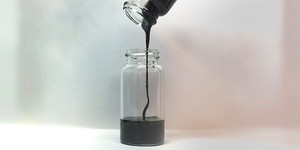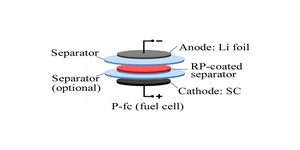Liquid-like solid could boost battery life
March 27, 2012 | 11:46
Companies: #chinese-academy-of-science

Researchers from the Chinese Academy of Science's Shanghai Institute of Ceramics, Brookhaven National Laboratory, the University of Michigan and the California Institute of Technology (Caltech) have released details of a liquid-like compound they claim could lead to more efficient thermoelectric devices.
Thermoelectric materials turn heat into electricity, and are seeing increasing use in waste energy reclamation projects. Using a thermoelectric material, it's possible to turn wasted heat from industrial facilities or vehicle engines into useful electricity.
The technology works by exploiting the temperature differential between its two ends. Electrons in the hot end diffuse to the cold end, producing a small but useful electric current. While current thermoelectric systems are typically bulky, the technology shows real promise for extending battery life in laptops and even smartphones by harnessing wasted heat - or even the heat of the user's hand - to generate a top-up current for the battery.
A key milestone in achieving this is increasing the efficiency of the thermoelectric material, which will result in the creation of smaller thermoelectric devices. It's this goal that the team at Caltech had in mind while experimenting with new compounds - including their most promising candidate yet, a mixture of copper and selenium which exhibits liquid-like behaviours despite being a solid.
'It's like a wet sponge,' explained Jeff Snyder, a faculty associate in applied physics and materials science at Caltech and a research team member, at the announcement. 'If you have a sponge with very fine pores in it, it looks and acts like a solid. But inside, the water molecules are diffusing just as fast as they would if they were a regular liquid. That's how I imagine this material works. It has a solid framework of selenium atoms, but the copper atoms are diffusing around as fast as they would in a liquid.'
The new compound features a mixture of crystalline and amorphous properties, allowing electrons to flow easily while inhibiting the transmission of the vibrations which carry heat. Using the crystal structure of selenium with free-flowing copper atoms which act like a liquid, the team created a compound with a thermoelectric figure of merit of 1.5 at 1000 degrees Kelvin - one of the highest values of any mass-producible material, the team claims.
A compound of copper and selenium isn't new: back in 1970 NASA was using a similar material in the construction of spacecraft power systems. Its liquid-like nature, however, was poorly understood and made it difficult to work with. The team's new research sheds light on the reasons for its high figure of merit, while paving the way for exploitation of other liquid-like thermoelectric materials in the future.
The team's research has been published in the Nature Materials journal.
Thermoelectric materials turn heat into electricity, and are seeing increasing use in waste energy reclamation projects. Using a thermoelectric material, it's possible to turn wasted heat from industrial facilities or vehicle engines into useful electricity.
The technology works by exploiting the temperature differential between its two ends. Electrons in the hot end diffuse to the cold end, producing a small but useful electric current. While current thermoelectric systems are typically bulky, the technology shows real promise for extending battery life in laptops and even smartphones by harnessing wasted heat - or even the heat of the user's hand - to generate a top-up current for the battery.
A key milestone in achieving this is increasing the efficiency of the thermoelectric material, which will result in the creation of smaller thermoelectric devices. It's this goal that the team at Caltech had in mind while experimenting with new compounds - including their most promising candidate yet, a mixture of copper and selenium which exhibits liquid-like behaviours despite being a solid.
'It's like a wet sponge,' explained Jeff Snyder, a faculty associate in applied physics and materials science at Caltech and a research team member, at the announcement. 'If you have a sponge with very fine pores in it, it looks and acts like a solid. But inside, the water molecules are diffusing just as fast as they would if they were a regular liquid. That's how I imagine this material works. It has a solid framework of selenium atoms, but the copper atoms are diffusing around as fast as they would in a liquid.'
The new compound features a mixture of crystalline and amorphous properties, allowing electrons to flow easily while inhibiting the transmission of the vibrations which carry heat. Using the crystal structure of selenium with free-flowing copper atoms which act like a liquid, the team created a compound with a thermoelectric figure of merit of 1.5 at 1000 degrees Kelvin - one of the highest values of any mass-producible material, the team claims.
A compound of copper and selenium isn't new: back in 1970 NASA was using a similar material in the construction of spacecraft power systems. Its liquid-like nature, however, was poorly understood and made it difficult to work with. The team's new research sheds light on the reasons for its high figure of merit, while paving the way for exploitation of other liquid-like thermoelectric materials in the future.
The team's research has been published in the Nature Materials journal.

MSI MPG Velox 100R Chassis Review
October 14 2021 | 15:04








Want to comment? Please log in.